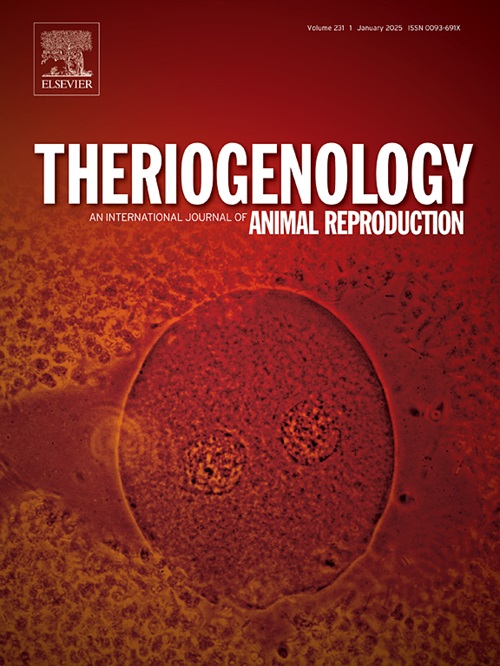Improving the efficacy of progesterone pessary treatment for synchrony of estrus in the sheep
IF 2.5
2区 农林科学
Q3 REPRODUCTIVE BIOLOGY
引用次数: 0
Abstract
Treatment with intra–vaginal progesterone pessaries for synchrony of estrus is essential in fixed–time artificial insemination (AI) of sheep. Globally, the conventional 14-day pessary treatment is the mainstay of commercial AI programs. It has remained largely unchanged for many decades even though it is associated with variable patterns of estrus and often disappointing pregnancy rates. Until recently, an understanding of this variability has been elusive. Here we review research of the last 25 years and conclude that synchronising estrus and obtaining satisfactory pregnancy rates (≥75 %) following AI is more challenging than expected from the original research of the 1960s. In particular, conventional pessary treatment is unable to control the time of emergence of the ovulatory follicle and the resultant variability in follicle age affects fertility. Additionally, the pessary is unable to mitigate the effects of season, nutrition and cyclical status of the ewe on the timing of estrus. It is concluded that the inability of pessary treatment to produce a uniform synchrony together with the adverse effects on follicle quality are primarily responsible for variable pregnancy rates. However, there are strategies to improve AI success rates. The first involves controlling the time of emergence of the ovulatory follicle so that it occurs primarily during the most fertile period of pessary treatment (Days 7–9 of a 14-day treatment). The second involves improving the synchrony of estrus by enhancing circulating levels of progesterone late (Day 9) in the treatment period. The third involves the use of short–term pessary treatments (5–7 days) that avoid some of the abnormalities associated with conventional treatment. Finally, given the variability in the timing of estrus, we address the challenge of optimising the time of insemination, an essential requirement of successful AI programs.
提高黄体酮栓剂对绵羊同步发情的疗效。
在绵羊的固定时间人工授精(AI)中,使用阴道内黄体酮栓剂进行同步发情治疗至关重要。在全球范围内,传统的 14 天雌激素治疗是商业人工授精项目的主流。几十年来,尽管发情模式多变,妊娠率往往令人失望,但这一方法基本未变。直到最近,人们才对这种变异性有所了解。在此,我们回顾了过去 25 年的研究,并得出结论:人工授精后同步发情并获得令人满意的妊娠率(≥75%)比 20 世纪 60 年代最初的研究预期更具挑战性。特别是,传统的栓塞治疗无法控制排卵卵泡出现的时间,因此卵泡年龄的变化会影响受精率。此外,阉割疗法无法减轻季节、营养和母羊周期性状态对发情时间的影响。结论是,雌激素治疗无法产生一致的同步性,加上对卵泡质量的不利影响,是造成受孕率不稳定的主要原因。不过,也有提高人工授精成功率的策略。首先是控制排卵卵泡出现的时间,使其主要出现在雌激素治疗的最易受孕期(14 天治疗中的第 7-9 天)。第二种方法是在治疗后期(第 9 天)通过提高循环中的孕酮水平来改善发情的同步性。第三种方法是使用短期雌激素疗法(5-7 天),以避免与传统疗法相关的一些异常现象。最后,考虑到发情时间的可变性,我们提出了优化人工授精时间的挑战,这是人工授精计划取得成功的基本要求。
本文章由计算机程序翻译,如有差异,请以英文原文为准。
求助全文
约1分钟内获得全文
求助全文
来源期刊

Theriogenology
农林科学-生殖生物学
CiteScore
5.50
自引率
14.30%
发文量
387
审稿时长
72 days
期刊介绍:
Theriogenology provides an international forum for researchers, clinicians, and industry professionals in animal reproductive biology. This acclaimed journal publishes articles on a wide range of topics in reproductive and developmental biology, of domestic mammal, avian, and aquatic species as well as wild species which are the object of veterinary care in research or conservation programs.
 求助内容:
求助内容: 应助结果提醒方式:
应助结果提醒方式:


